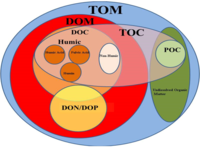
Photo from wikipedia
Abstract Seventeen coal and carbonaceous shale samples taken from eight stratigraphic sections of the Devonian Hecla Bay and Weatherall formations in Arctic Canada, were examined using reflected light microscopy, instrumental… Click to show full abstract
Abstract Seventeen coal and carbonaceous shale samples taken from eight stratigraphic sections of the Devonian Hecla Bay and Weatherall formations in Arctic Canada, were examined using reflected light microscopy, instrumental neutron activation analysis (INAA), and inductively coupled plasma emission spectroscopy (ICPES). Samples consist of humic coal with 62–79 vol% vitrinite, liptinite-rich humic coal with 42 vol% liptinite, and cannel coal with 52–81 vol% sporinite content. Carbonaceous shale has 46–73 vol% mineral matter and canneloid shale has 30–42 vol% mineral matter as well as 22–38 vol% sporinite content. Most were deposited in areas characterized by minor channel cut-and-abandonment and lake and bay infills peripheral to distributary complexes. A fresh water environment is indicated by Boron (18–71 ppm), low inertinite (0–7.8 wt%), and high sporinite content (30–81 vol%). The ratio of Na/K versus liptinite content shows that coals and associated sediments from the Hecla Bay Formation experienced a more rapid rate of sedimentation than the carbonaceous shales from the Weatherall Formation. The highest total REEs and LREE (La-Gd) was in the liptinite-rich humic coal, followed by humic coal and carbonaceous shale. The concentration of REEs and LREEs in the cannel coals is half of that measured in the liptinite-rich humic coal. The PAAS normalized for oil shales follows two different patterns: 1) the liptinite-rich coal samples display a sharp increase from Nd to Ho, then maintain a similar pattern up to Lu; and 2) samples of other lithologies increase from Nd to Dy, and then maintain a flat trend up to Lu. Hierarchical cluster analysis shows that canneloid and liptinite-rich coal exhibit the greatest similarity with each other whereas humic coal and liptinite-rich coal show the greatest dissimilarity with carbonaceous shale.
Journal Title: Chemical Geology
Year Published: 2018
Link to full text (if available)
Share on Social Media: Sign Up to like & get
recommendations!